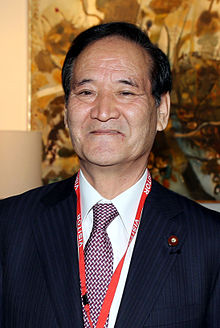Kōya Nishikawa

Kōya Nishikawa ( Japanese 西川 公 也 , Nishikawa Kōya ; born December 26, 1942 in the city of Ujiie , today part of the independent city of Sakura , Shioya County , Tochigi Prefecture ) is a Japanese politician of the Liberal Democratic Party ( Nikai faction ), a member of the Shūgiin , the lower house of the national parliament, for the proportional electoral block North-Kantō and former Minister of Agriculture .
Nishikawa was after his studies at the agricultural faculty of the Tōkyō Nōkō Daigaku and at the graduate college there in 1967 employees of the prefecture administration of Tochigi. In 1979 he was elected to the Tochigi Prefectural Parliament for the first of five terms. From 1993 to 1994 he was President of the Prefectural Parliament. In 1996 he resigned to switch to national politics.
In the 1996 Shūgiin election , the first after the introduction of single-mandate constituencies and proportional representation, Nishikawa ran for the LDP in Tochigi 2 and sat down with an absolute majority against the ex-socialist Mamoru Kobayashi (now the Democratic Party , until then one of the five MPs for the old constituency 1) and two other candidates. In 2000 he was able to defend the seat against Kobayashi. In 2001 he was appointed Mori daijin seimukan for the second cabinet (the lower of the two newly introduced parliamentary state secretary posts ) in the cabinet office ( naikakufu ), which was also newly established in 2001 . For the subsequent cabinets of Jun'ichirō Koizumi Nishikawa was Parliamentary State Secretary in the Ministry of Economic Affairs in 2002 , again in the Cabinet Office in 2003, and then fukudaijin ("Vice Minister", the upper of the two parliamentary offices under the Minister) in 2004 .
In Shūgiin elections, Nishikawa had meanwhile ceded the constituency of Tochigi 2 to Justice Minister Mayumi Moriyama , who exceeded the age limit for LDP proportional representation candidates introduced under Koizumi, and only ran for proportional representation in the North Kantō proportional electoral block, where he stood in a group of proportional representation candidates who were nominated before the double candidates the top of the LDP list in 2003 and 2005 was safely re-elected. For the 2009 Shūgiin election , Moriyama initially wanted to move to constituency 3 in the northeast, neighboring constituency of Yoshimi Watanabe , who had left the LDP , but ultimately withdrew from politics. Nishikawa took over the LDP candidacy again in constituency 2, but where he was clearly defeated (36% to 63%) in the election to the former governor Akio Fukuda , who ran for the Democratic Party.
In the Shūgiin election in 2012 , Nishikawa received around 56,000 votes, again over 9,000 votes less than in 2009, but still won the constituency with 38.6%, as the voter turnout had fallen significantly and Yoshimi Watanabe's Minna no Tō was also a competitive candidate for Tochigi had nominated 2, and moved back into the House of Commons. He became chairman of the TPP committee ( tīpīpī taisaku iinkai , TPP 対 策 委員会 ) of the LDP in 2013 . In a cabinet reshuffle in September 2014 , Shinzō Abe appointed him to the head of the Ministry of Agriculture, Forestry and Fisheries. In the election in December of the same year he received more votes than in 2012 (> 62,000, 46.5%), but lost around 200 votes to Akio Fukuda; with the very narrow defeat, he led the LDP proportional representation in the North Kantō block and won a seat there.
Shinzō Abe initially took Nishikawa into his third cabinet , but he resigned in February 2015 over a donation scandal.
Web links
- Official Website (Japanese)
- Shūgiin, MP profiles : Nishikawa Kōya (Japanese)
- NHK World , September 9, 2014: English summary of an interview with Nishikawa on taking office as Minister of Agriculture
Individual evidence
- ^ Tochigi Prefectural Parliament: Presidents and Vice-Presidents since 1879
- ↑ Masaaki Kameda: Farm minister Nishikawa resigns over donation scandal. In: The Japan Times . February 23, 2015, accessed October 13, 2016 .
| personal data | |
|---|---|
| SURNAME | Nishikawa, Kōya |
| ALTERNATIVE NAMES | 西川 公 也 (Japanese) |
| BRIEF DESCRIPTION | Japanese politician |
| DATE OF BIRTH | December 26, 1942 |
| PLACE OF BIRTH | Ujiie , now Sakura , Shioya County , Tochigi Prefecture |